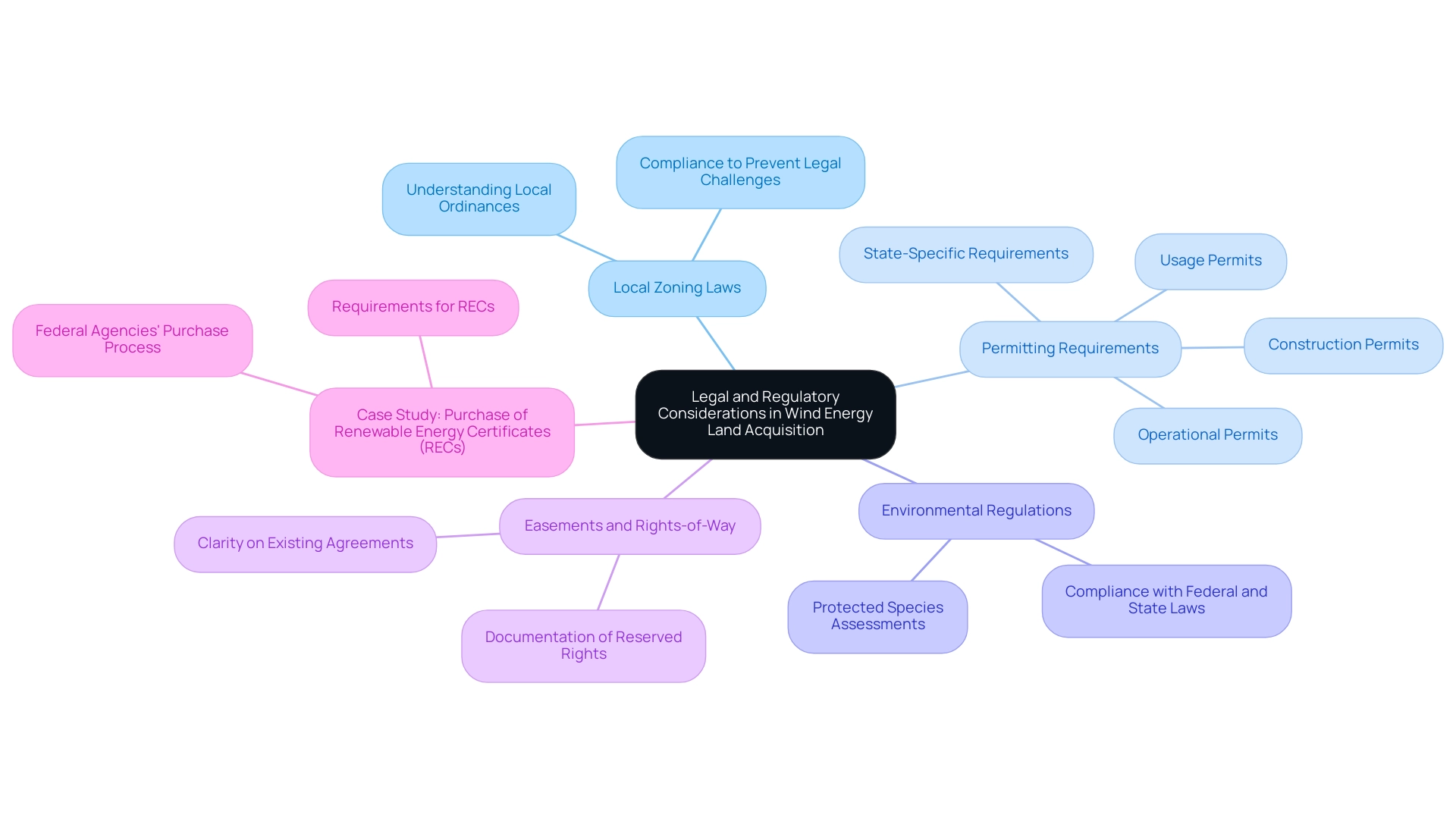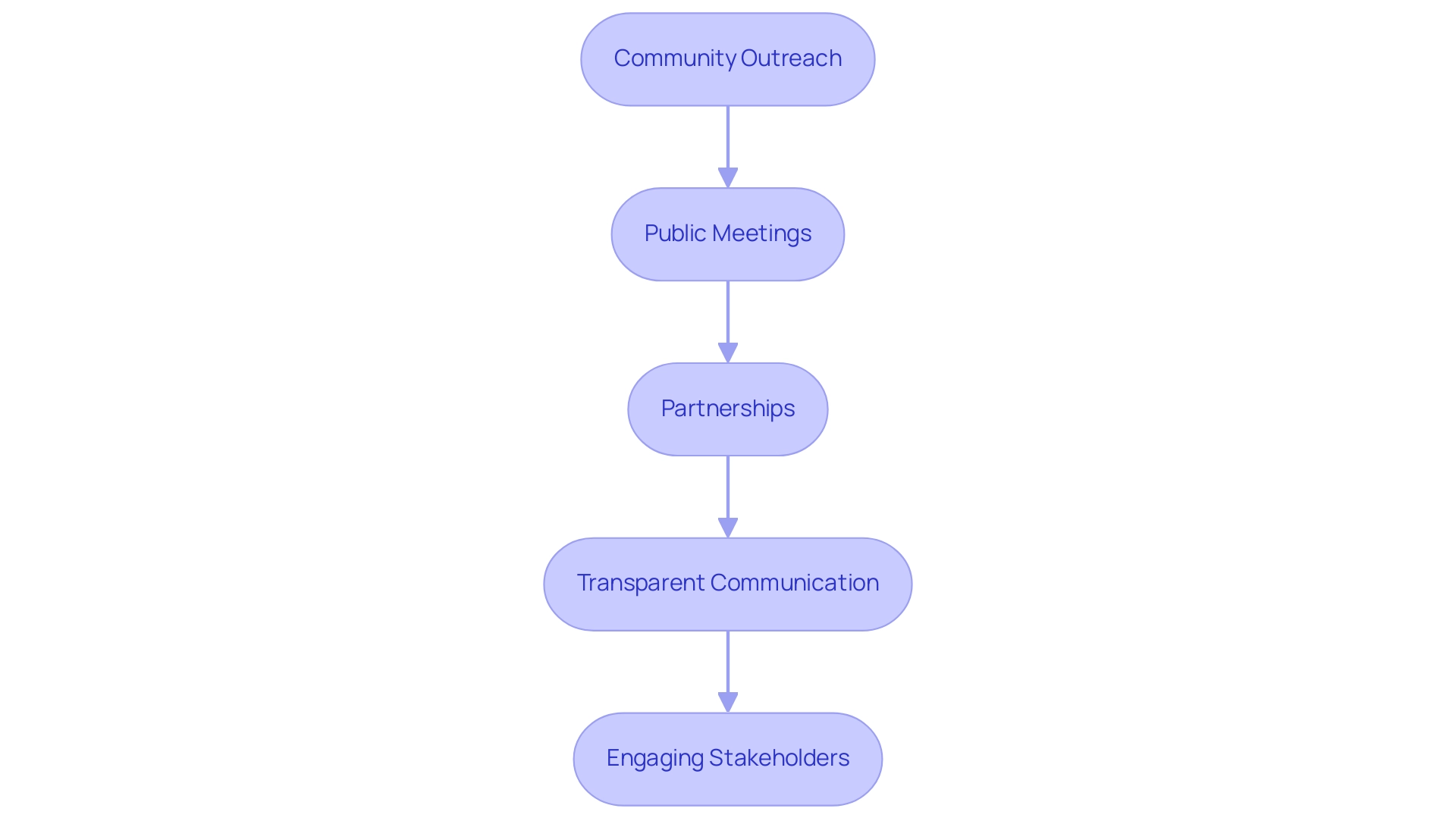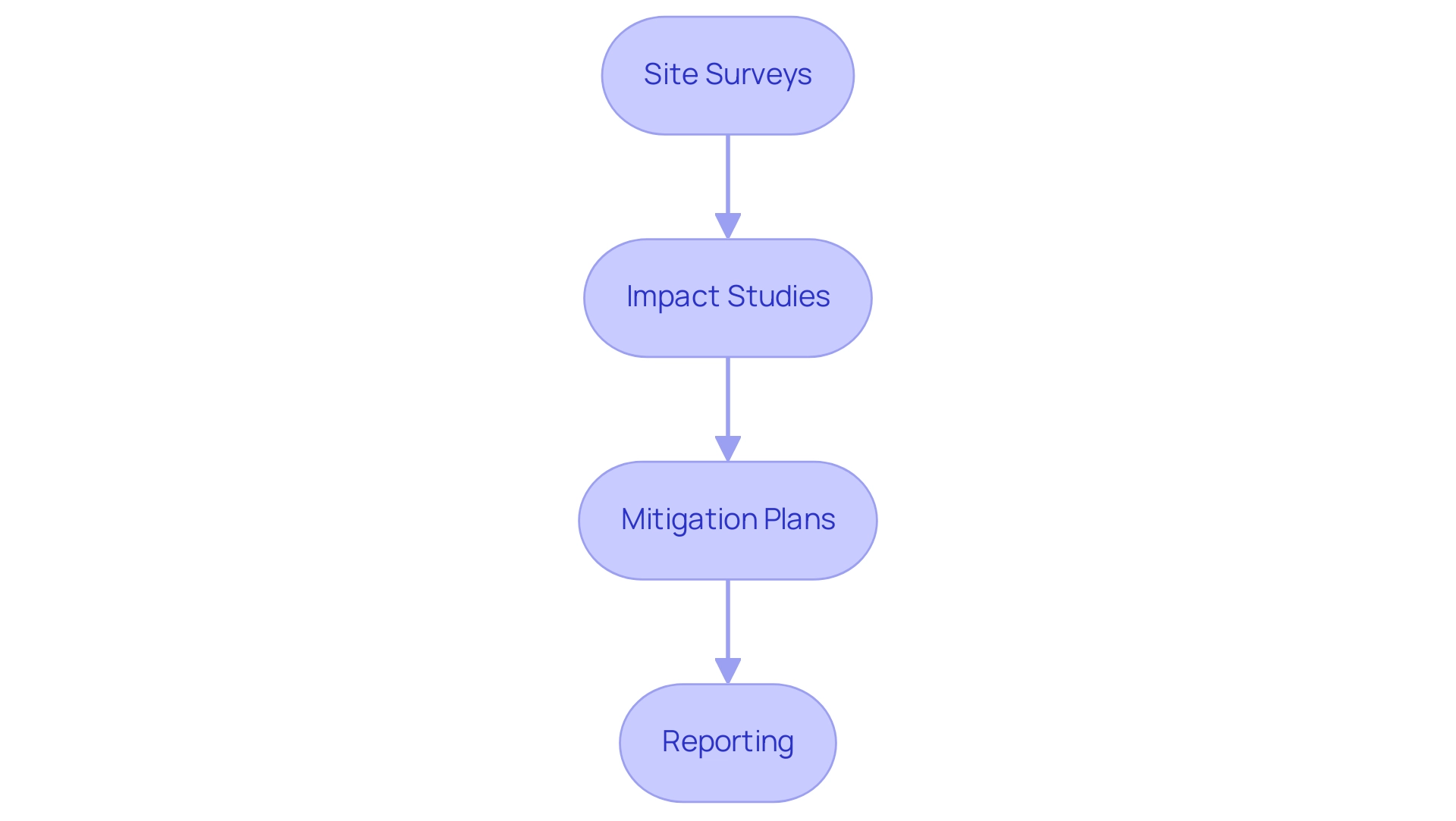Introduction
The development of wind energy projects represents a significant opportunity to harness renewable resources, yet it is accompanied by a complex landscape of land requirements and regulatory considerations. Understanding the intricacies involved in land acquisition is essential for stakeholders aiming to navigate this process effectively.
Key factors such as:
- Site assessments
- Zoning laws
- Environmental impacts
must be meticulously analyzed to ensure compliance and foster community support. As the demand for sustainable energy sources grows, the importance of strategic land acquisition becomes increasingly evident, necessitating a comprehensive approach that balances environmental stewardship with local economic benefits.
This article delves into the critical aspects of land requirements, acquisition processes, and the vital role of stakeholder engagement in advancing wind energy initiatives.
Understanding Land Requirements for Wind Energy Projects
Grasping the space needs for renewable energy initiatives is essential before engaging in wind energy land acquisition consulting. Several key factors must be carefully considered:
-
Size and Layout: Accurately calculating the total area required for a renewable energy farm is essential.
This involves not only the space for the turbines but also for access roads and maintenance facilities as part of wind energy land acquisition consulting. The typical territory required for energy farms can differ greatly depending on the technology applied and the particular arrangement of the location. -
Zoning and Land Use: It is crucial to confirm that the area in question is suitable for wind energy land acquisition consulting and development.
Compliance with local land use regulations is non-negotiable, and recent updates to zoning laws should be closely monitored in wind energy land acquisition consulting to avoid any legal complications. -
Proximity to Infrastructure: Assessing the distance to existing power lines and roads is vital for wind energy land acquisition consulting, as it facilitates energy transmission and ensures maintenance access. Effective planning in this area can significantly reduce operational expenses over the initiative's lifespan.
-
Environmental Considerations: Identifying any environmental restrictions that may influence property use is critical.
This includes recognizing protected areas or wildlife habitats that could impose limitations on development. -
Local Economic Impact: Renewable operators may commit to hiring locally and supporting technical education initiatives, which can enhance community engagement and economic growth.
In light of recent discussions regarding the economic effects of renewable initiatives, such as Kansas' lifetime local property tax exemption resulting in an estimated loss of $82 million per year across 24 counties, it becomes even more important to engage in wind energy land acquisition consulting strategically. Carla McLane, Planning Director of Morrow County, underscores this by stating,To remedy this issue, Morrow County used the revenue it collected from various SIP agreements to expand housing options.
Moreover, a pertinent case analysis from Chaves County, New Mexico, emphasizes how the presence of a building inspector enables the county to keep fees accrued from the permitting process for renewable initiatives, benefiting local staff and services.
By collecting this information beforehand, including recent updates on area needs for renewable initiatives, you can simplify the acquisition process and reduce possible obstacles.
Navigating the Land Acquisition Process: Key Steps and Considerations
The land acquisition process for wind energy projects encompasses several essential steps that stakeholders must meticulously follow to ensure successful negotiations and agreements:
- Initial Site Assessment: Begin with a thorough evaluation of potential sites, identifying areas that meet specific project requirements, such as proximity to existing infrastructure and environmental considerations.
- Engaging Property Owners: Initiate discussions with property owners to explore their willingness to lease or sell space for wind energy land acquisition consulting purposes. This stage is crucial for building rapport and understanding landowner perspectives.
- Negotiation: Enter discussions, concentrating on critical terms such as lease duration, compensation rates, and usage rights. Effective negotiation strategies are vital in addressing landowners' concerns and ensuring mutually beneficial agreements.
- Contract Drafting: After reaching a consensus on terms, draft a comprehensive contract that clearly delineates the obligations and rights of both the developer and the landowner. This document should reflect all negotiated points accurately.
- Finalization: Conduct a final review of the contract to ensure compliance with legal requirements and secure all necessary signatures. This step is essential for protecting both parties' interests.
By adhering to these structured steps, stakeholders can adeptly navigate the complexities of wind energy land acquisition consulting. Notably, communities are increasingly engaging with wind energy developers to create educational opportunities, such as partnerships with community colleges that offer scholarships and training programs for local residents, thereby preparing them for careers in wind energy. These initiatives not only facilitate property acquisition but also strengthen community ties and promote local workforce development.
As Carla McLane, Planning Director of Morrow County, aptly noted, "To remedy this issue, Morrow County used the revenue it collected from various SIP agreements to expand housing options," highlighting the broader benefits of strategic agreements. Additionally, it is important to note that SIPs include a 15-year tax exemption, with a monetary threshold that fluctuates depending on the local population, providing further incentive for landowners to consider agreements. Resources are also accessible for landowners to navigate renewable contracts and agreements, ensuring they are well-informed throughout the process.
Legal and Regulatory Considerations in Wind Energy Land Acquisition
Navigating the legal and regulatory environment is essential for successful property acquisition in renewable energy projects, particularly in the context of wind energy land acquisition consulting, as detailed in the comprehensive 51-page document. Key considerations include:
- Local Zoning Laws: Comprehending local zoning ordinances is essential, as these regulations can significantly affect use and development. Compliance with these laws helps prevent potential legal challenges.
- Permitting Requirements: It is imperative to identify the necessary permits for usage, construction, and operation of wind facilities. The process may vary by state; thus, familiarity with state-specific requirements is vital. As emphasized by the Bureau of Land Management, "This final rule sets rates that are also increased annually, through the annual adjustment factor," which is a crucial detail for budgeting and planning.
- Environmental Regulations: Stakeholders must grasp the environmental laws that govern usage of territory. This includes understanding the assessments required for protected species and habitats to ensure compliance with federal and state regulations.
- Easements and Rights-of-Way: Clarity regarding existing easements or rights-of-way is essential, as these agreements can impact property use and potentially lead to disputes. Landowners should clearly document any reserved rights when transferring property to avoid legal complications in the future.
Furthermore, a relevant case study is the Purchase of Renewable Energy Certificates (RECs), which illustrates how federal agencies can purchase RECs separately from their electricity to meet renewable electricity requirements, provided the RECs are from facilities placed in service within a specified timeframe. By thoroughly understanding these legal considerations, stakeholders can mitigate risks and ensure compliance throughout the wind energy land acquisition consulting process.

Engaging Stakeholders: Building Community Support for Wind Projects
Involving stakeholders is crucial in the wind energy land acquisition consulting process for initiatives. Effective strategies to facilitate this engagement include:
-
Community Outreach: Begin by communicating with local residents to explain the initiative’s objectives and benefits, while also addressing any concerns they may express.
This establishes a foundation of trust and transparency.
-
Public Meetings: Organize public meetings to provide regular updates on the initiative’s progress and actively solicit feedback from the community. This approach not only informs stakeholders but also empowers them to voice their opinions.
-
Partnerships: Collaborate with local organizations and advocacy groups, leveraging their insights and connections to build broader support and better align the initiative with community interests. Such partnerships can enhance credibility and foster goodwill.
-
Transparent Communication: Uphold open communication channels throughout the initiative lifecycle, ensuring stakeholders remain informed and engaged.
This ongoing conversation can greatly lessen misconceptions and dissent.
By actively engaging the community in the development process, developers can foster positive relationships and alleviate potential resistance, ultimately enabling a smoother process in wind energy land acquisition consulting for renewable initiatives. The financial consequences of community involvement are emphasized by the statistic that the lifetime local property tax exemption for wind-related initiatives in Kansas led to an estimated loss of $82 million annually, underscoring the significance of addressing local issues. As Carla McLane, Planning Director of Morrow County, notes, 'To remedy this issue, Morrow County used the revenue it collected from various SIP agreements to expand housing options,' illustrating the potential for collaborative efforts to yield community benefits.
Furthermore, the case study titled 'Kansas Tax Exemption Impact' serves as a reminder of the consequences of inadequate stakeholder engagement, emphasizing the necessity of negotiating with local communities to prevent similar issues in future initiatives.

Conducting Environmental Assessments: Ensuring Sustainable Land Use
Conducting comprehensive environmental assessments is vital for promoting sustainable land use in wind energy land acquisition consulting initiatives. Essential components of these assessments include:
-
Site Surveys: Conduct thorough surveys to identify sensitive habitats, wildlife, and unique ecological features within the proposed development area.
This step is crucial for informed decision-making, as it helps elucidate the specific environmental attributes that may be impacted.
-
Impact Studies: Assess the potential effects of the initiative on local ecosystems. This includes analyzing factors such as noise pollution, shadow flicker, and disruptions to wildlife habitats.
Recent studies have highlighted the varying ecological impacts of turbine farms, underscoring the necessity of detailed assessments to ensure minimal disruption.
-
Mitigation Plans: Formulate strategies to address any negative impacts identified during the assessment process. These plans should outline compliance with environmental regulations and propose measures to effectively mitigate potential harm to local ecosystems.
-
Reporting: Compile comprehensive reports that summarize findings and proposed mitigation strategies for review by regulatory authorities. These reports are essential for transparency and facilitate informed decision-making regarding project approvals.
For instance, the shortest recorded approval timeline was just 35 days for a 51-megawatt project in Nova Scotia, illustrating the potential efficiency of the assessment process when conducted effectively.
By prioritizing environmental assessments, stakeholders can enhance sustainability and reduce ecological disruption, which is essential in wind energy land acquisition consulting to align their endeavors with best practices in environmental stewardship.
Additionally, positioning a renewable energy farm on previously contaminated land not only remediates the site but also contributes positively to local environmental quality. This strategic planning exemplifies how replacing a coal-fired power plant with wind farms can lead to significant ecological benefits.
Furthermore, the case study titled 'Environmental Assessment for Wind Energy Development in Canada' highlights the variability in assessment requirements and its implications for developers, emphasizing the need for tailored approaches in different jurisdictions.
Such strategic planning can lead to successful projects that resonate with community values, demonstrating the significant role of thorough assessments in achieving both energy production and ecological preservation.

Conclusion
Strategic land acquisition for wind energy projects is a multifaceted process that necessitates careful consideration of various factors. From understanding site requirements and zoning laws to addressing environmental impacts and engaging local communities, stakeholders must navigate a complex landscape to ensure project success. Each stage of the acquisition process, including:
- Site assessments
- Negotiations with landowners
- Adherence to legal regulations
plays a critical role in laying the groundwork for sustainable energy development.
Engaging stakeholders effectively is equally vital. By fostering transparent communication and building community support, developers can mitigate resistance and enhance project acceptance. The examples provided throughout the article, such as the partnerships formed in Morrow County and the lessons learned from Kansas, underscore the importance of addressing local concerns and enhancing community involvement in wind energy initiatives.
Ultimately, the successful implementation of wind energy projects hinges on a comprehensive approach that balances environmental stewardship with economic benefits for local communities. As the demand for renewable energy continues to rise, understanding and addressing the intricacies of land acquisition will be essential for stakeholders seeking to contribute meaningfully to a sustainable energy future.
Frequently Asked Questions
What are the key factors to consider before engaging in wind energy land acquisition consulting?
Key factors include size and layout of the land, zoning and land use regulations, proximity to existing infrastructure, environmental considerations, and local economic impact.
Why is the size and layout of the land important for renewable energy farms?
Accurately calculating the total area required is essential, as it includes space for turbines, access roads, and maintenance facilities. The required territory can vary based on technology and site arrangement.
How do zoning and land use regulations affect wind energy land acquisition?
It is crucial to ensure that the area is suitable for wind energy development and complies with local land use regulations. Monitoring updates to zoning laws is necessary to avoid legal complications.
What role does proximity to infrastructure play in land acquisition for wind energy?
Assessing the distance to existing power lines and roads is vital for facilitating energy transmission and maintenance access, which can significantly reduce operational expenses.
What environmental considerations must be taken into account?
Identifying environmental restrictions, such as protected areas or wildlife habitats, is critical as these can impose limitations on land development.
How can local economic impact influence renewable energy initiatives?
Renewable operators may hire locally and support education initiatives, enhancing community engagement and economic growth. Strategic engagement in land acquisition can help mitigate potential economic issues.
What are the essential steps in the land acquisition process for wind energy projects?
The essential steps include initial site assessment, engaging property owners, negotiation, contract drafting, and finalization.
Why is the initial site assessment important?
It involves evaluating potential sites to ensure they meet specific project requirements, such as proximity to infrastructure and environmental considerations.
What is the significance of engaging property owners in the acquisition process?
Initiating discussions with property owners helps build rapport and understand their perspectives on leasing or selling land for wind energy projects.
What should be included in the negotiation phase of land acquisition?
Critical terms such as lease duration, compensation rates, and usage rights should be discussed to address landowners' concerns and ensure mutually beneficial agreements.
What is the purpose of contract drafting in the land acquisition process?
A comprehensive contract should clearly outline the obligations and rights of both the developer and the landowner, reflecting all negotiated points accurately.
What is involved in the finalization step of the land acquisition process?
A final review of the contract is conducted to ensure compliance with legal requirements and secure necessary signatures, protecting both parties' interests.




